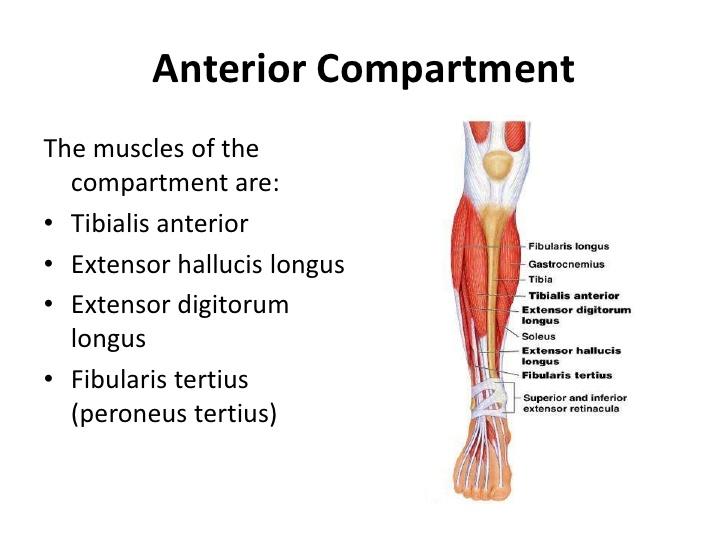Chronic exertional compartment syndrome (CECS)
Chronic exertional compartment syndrome (CECS)
It is a compartment syndrome - the tibialis anterior muscle swells with exercise producing relative muscle ischaemia as the muscle expansion is restricted by the non expansile fascial compartment - may be numbness of the big toe.
- CECS may be difficult to diagnose, but it is most commonly affects the anterior compartment
Anterior compartment of lower leg (1):

- CECS is a condition of increased pressure in the fascial compartments (muscles and neurovascular structures bound by fascia and bone) related to exercise leads to recurrent episodes of pain
- symptoms are bilateral 85% to 95% of the time
- pathophysiology of CECS is multifactorial. Factors may include (2,3,4):
- constraints of a fixed muscular compartment, normal or abnormal muscle swelling that occurs with activity, abnormally thickened fascia, normal muscle hypertrophy in response to resistance training, or dynamic contraction patterns during gait
- low muscle capillary supply is a pathogenic factor in chronic compartment syndrome
- CECS is prevalent equally in both sexes with a median age of onset of 20-years-old and is associated with diabetes mellitus
CECS: Compartment Pressure Testing (5)
- compartment pressure testing is the gold standard for CECS
- pre-exertional and post-exertional measurements are needed
- the post-exertional measurements should be taken within 5 minutes of the exercise; the athlete should be symptomatic at the time of measurement
- a positive compartment pressure test is a pre-exercise resting pressure of 15 mmHg or greater and/or a 1-minute postexercise pressure of 30 mmHg or greater and/or a 5-minute postexercise pressure of 20 mmHg or greater
Reference:
- Faez M. The anatomy of the leg. SlideShare.
- Brennan FH, Kane SF. Diagnosis, treatment options, and rehabilitation of chronic lower leg exertional compartment syndrome. Curr Sports Med Rep. 2003;2:247-250
- Raikin S, Venkat R, Vitanzo P. Bilateral simultaneous fasciotomy for chronic exertional compartment syndrome. Foot Ankle Int 2005; 26: 1007-1011
- Shah S, Miller B, Kuhn J. Chronic exertional compartment syndrome. Am J Orthop 2004; 33: 335-341
- Pedowitz RA, Hargens AR, Mubarak SJ, Gershuni DH. Modified criteria for the objective diagnosis of chronic compartment syndrome of the leg. Am J Sports Med. 1990;18:35-40.
Related pages
Create an account to add page annotations
Annotations allow you to add information to this page that would be handy to have on hand during a consultation. E.g. a website or number. This information will always show when you visit this page.